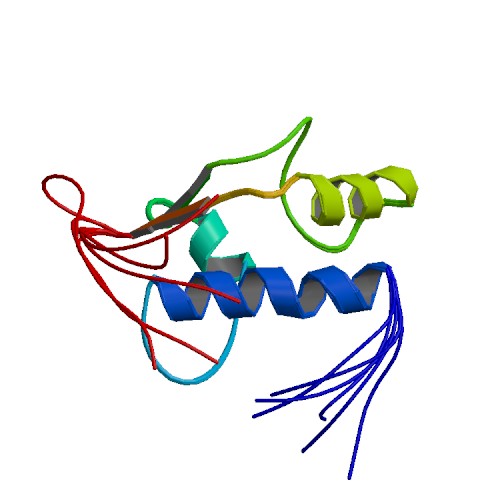GTF2IRD1
| GTF2I repeat domain containing 1 | |||||||||||||
|---|---|---|---|---|---|---|---|---|---|---|---|---|---|
 PDB rendering based on 2d99. | |||||||||||||
| |||||||||||||
| Identifiers | |||||||||||||
| Symbols | GTF2IRD1 ; WBS; CREAM1; GTF3; MUSTRD1; RBAP2; WBSCR11; WBSCR12; hMusTRD1alpha1 | ||||||||||||
| External IDs | Template:OMIM5 Template:MGI HomoloGene: 4158 | ||||||||||||
| |||||||||||||
| Orthologs | |||||||||||||
| Template:GNF Ortholog box | |||||||||||||
| Species | Human | Mouse | |||||||||||
| Entrez | n/a | n/a | |||||||||||
| Ensembl | n/a | n/a | |||||||||||
| UniProt | n/a | n/a | |||||||||||
| RefSeq (mRNA) | n/a | n/a | |||||||||||
| RefSeq (protein) | n/a | n/a | |||||||||||
| Location (UCSC) | n/a | n/a | |||||||||||
| PubMed search | n/a | n/a | |||||||||||
GTF2I repeat domain containing 1, also known as GTF2IRD1, is a human gene.[1]
The protein encoded by this gene contains five GTF2I-like repeats and each repeat possesses a potential helix-loop-helix (HLH) motif. It may have the ability to interact with other HLH-proteins and function as a transcription factor or as a positive transcriptional regulator under the control of Retinoblastoma protein. This gene is deleted in Williams-Beuren syndrome, a multisystem developmental disorder caused by deletion of multiple genes at 7q11.23. Alternative splicing of this gene generates at least 2 transcript variants.[1]
References
Further reading
- O'Mahoney JV, Guven KL, Lin J; et al. (1998). "Identification of a novel slow-muscle-fiber enhancer binding protein, MusTRD1". Mol. Cell. Biol. 18 (11): 6641–52. PMID 9774679.
- Osborne LR, Campbell T, Daradich A; et al. (1999). "Identification of a putative transcription factor gene (WBSCR11) that is commonly deleted in Williams-Beuren syndrome". Genomics. 57 (2): 279–84. doi:10.1006/geno.1999.5784. PMID 10198167.
- Tassabehji M, Carette M, Wilmot C; et al. (2000). "A transcription factor involved in skeletal muscle gene expression is deleted in patients with Williams syndrome". Eur. J. Hum. Genet. 7 (7): 737–47. doi:10.1038/sj.ejhg.5200396. PMID 10573005.
- Franke Y, Peoples RJ, Francke U (2000). "Identification of GTF2IRD1, a putative transcription factor within the Williams-Beuren syndrome deletion at 7q11.23". Cytogenet. Cell Genet. 86 (3–4): 296–304. PMID 10575229.
- Yan X, Zhao X, Qian M; et al. (2000). "Characterization and gene structure of a novel retinoblastoma-protein-associated protein similar to the transcription regulator TFII-I". Biochem. J. 345 Pt 3: 749–57. PMID 10642537.
- Tussié-Luna MI, Bayarsaihan D, Ruddle FH, Roy AL (2001). "Repression of TFII-I-dependent transcription by nuclear exclusion". Proc. Natl. Acad. Sci. U.S.A. 98 (14): 7789–94. doi:10.1073/pnas.141222298. PMID 11438732.
- Tussie-Luna MI, Michel B, Hakre S, Roy AL (2003). "The SUMO ubiquitin-protein isopeptide ligase family member Miz1/PIASxbeta /Siz2 is a transcriptional cofactor for TFII-I". J. Biol. Chem. 277 (45): 43185–93. doi:10.1074/jbc.M207635200. PMID 12193603.
- Tussié-Luna MI, Bayarsaihan D, Seto E; et al. (2002). "Physical and functional interactions of histone deacetylase 3 with TFII-I family proteins and PIASxbeta". Proc. Natl. Acad. Sci. U.S.A. 99 (20): 12807–12. doi:10.1073/pnas.192464499. PMID 12239342.
- Vullhorst D, Buonanno A (2003). "Characterization of general transcription factor 3, a transcription factor involved in slow muscle-specific gene expression". J. Biol. Chem. 278 (10): 8370–9. doi:10.1074/jbc.M209361200. PMID 12475981.
- Strausberg RL, Feingold EA, Grouse LH; et al. (2003). "Generation and initial analysis of more than 15,000 full-length human and mouse cDNA sequences". Proc. Natl. Acad. Sci. U.S.A. 99 (26): 16899–903. doi:10.1073/pnas.242603899. PMID 12477932.
- Hillier LW, Fulton RS, Fulton LA; et al. (2003). "The DNA sequence of human chromosome 7". Nature. 424 (6945): 157–64. doi:10.1038/nature01782. PMID 12853948.
- Polly P, Haddadi LM, Issa LL; et al. (2003). "hMusTRD1alpha1 represses MEF2 activation of the troponin I slow enhancer". J. Biol. Chem. 278 (38): 36603–10. doi:10.1074/jbc.M212814200. PMID 12857748.
- Hirota H, Matsuoka R, Chen XN; et al. (2004). "Williams syndrome deficits in visual spatial processing linked to GTF2IRD1 and GTF2I on chromosome 7q11.23". Genet. Med. 5 (4): 311–21. doi:10.1097/01.GIM.0000076975.10224.67. PMID 12865760.
- Lehner B, Sanderson CM (2004). "A protein interaction framework for human mRNA degradation". Genome Res. 14 (7): 1315–23. doi:10.1101/gr.2122004. PMID 15231747.
- Beausoleil SA, Jedrychowski M, Schwartz D; et al. (2004). "Large-scale characterization of HeLa cell nuclear phosphoproteins". Proc. Natl. Acad. Sci. U.S.A. 101 (33): 12130–5. doi:10.1073/pnas.0404720101. PMID 15302935.
- Gerhard DS, Wagner L, Feingold EA; et al. (2004). "The status, quality, and expansion of the NIH full-length cDNA project: the Mammalian Gene Collection (MGC)". Genome Res. 14 (10B): 2121–7. doi:10.1101/gr.2596504. PMID 15489334.
- Grimsby S, Jaensson H, Dubrovska A; et al. (2005). "Proteomics-based identification of proteins interacting with Smad3: SREBP-2 forms a complex with Smad3 and inhibits its transcriptional activity". FEBS Lett. 577 (1–2): 93–100. doi:10.1016/j.febslet.2004.09.069. PMID 15527767.
- Jackson TA, Taylor HE, Sharma D; et al. (2005). "Vascular endothelial growth factor receptor-2: counter-regulation by the transcription factors, TFII-I and TFII-IRD1". J. Biol. Chem. 280 (33): 29856–63. doi:10.1074/jbc.M500335200. PMID 15941713.
- Rual JF, Venkatesan K, Hao T; et al. (2005). "Towards a proteome-scale map of the human protein-protein interaction network". Nature. 437 (7062): 1173–8. doi:10.1038/nature04209. PMID 16189514.
- Tassabehji M, Hammond P, Karmiloff-Smith A; et al. (2005). "GTF2IRD1 in craniofacial development of humans and mice". Science. 310 (5751): 1184–7. doi:10.1126/science.1116142. PMID 16293761.
| This protein-related article is a stub. You can help Wikipedia by expanding it. |